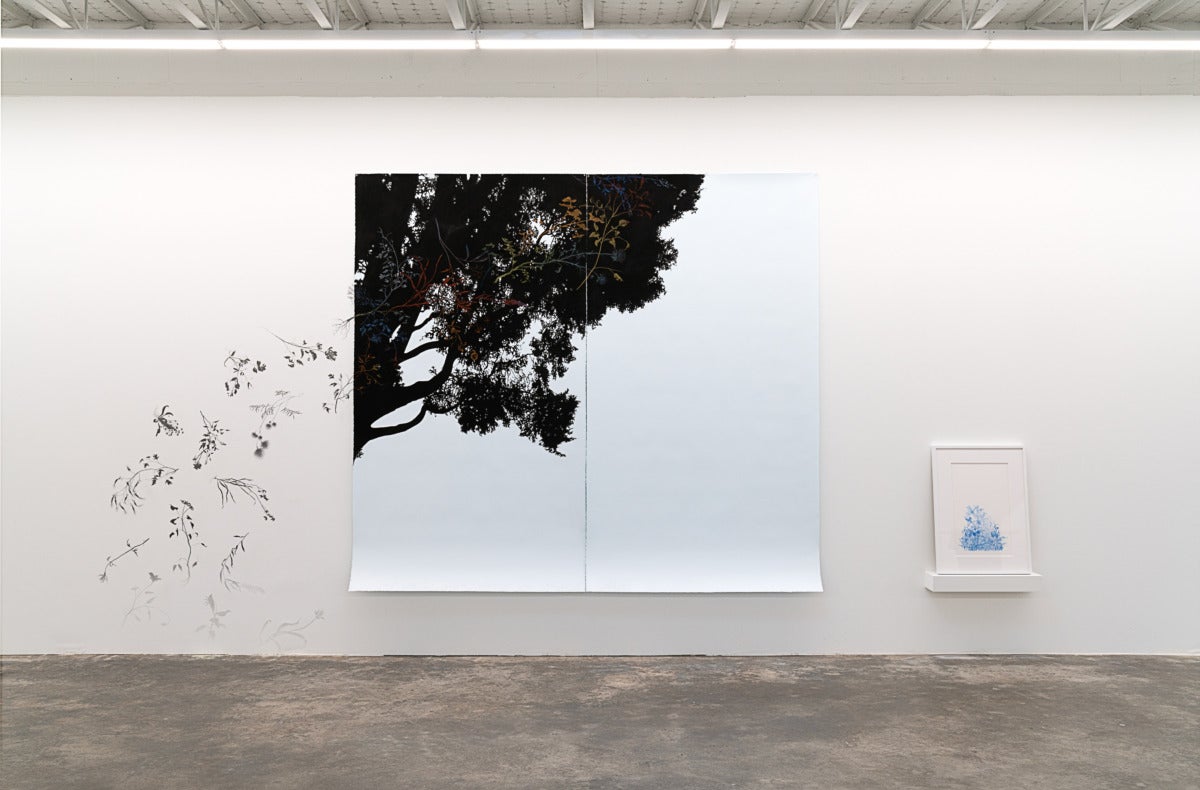
The solo exhibition of mid-career Canadian artist Zachari Logan titled The Blooming Skin at Wolfgang Gallery in Atlanta explores the relationship between humans and nature as rendered in immaculate pastel, graphite, red and blue pencil drawings, and acrylic and pastel paintings in scales ranging from minute to life-size. Located within the Back Gallery, this exhibition is found after walking past the Front Gallery and Dove Hall, both of which have concurrent exhibitions featuring other artists’ artworks.
Technical skill is at the forefront of this exhibition. Flora seamlessly blends into and out of human body parts. Heavily detailed, even when working at scales of only a few inches, the drawings are exacting and elegant. Most frequently executed in a monochromatic palette of graphite gray, rosy red, or cerulean blue, amputated body parts like half of a leg, a mouth, a skull, a foot, or an eye, are fused with vegetation such that the human elements visually take the place of flowers, branches, or roots within the plant structure. This skillful handling is sometimes executed in more limited capacities, such as Bone Garden Series (Blooming Leg), which features only one hybrid of a human leg and plant life, but is also extrapolated into complex compositions such as Autoportrait No. 1 (Wildflowers) from Grotesques Series (2022), which feature numerous mutations. The precise rendering of these mutations gives them a naturalistic feeling, although, of course, a human mouth growing from a flower is not biologically possible.

At times, the iconography can feel a little on-the-nose, lacking depth or nuance. The two skulls growing out of a plant in Bone Garden Series (Blooming Skulls) reads as a literal depiction of a life cycle. The handling of the medium and formal qualities of the artwork are well-manicured, but the imagery feels one-dimensional. However, these very literal metaphors are offset by their placement within a salon-style hanging on one wall of the gallery. Alone, these artworks might fall flat, but hung within a grouping, they join a larger narrative.
Fully rendered self-portraits of the artist’s own face emerge from a passion flower in one drawing and from a Chrysantha in another. The specificity of the face negatively impacts the anonymous human entanglement with nature the exhibition creates. Choosing to depict the artist’s own face and no others, makes the artworks feel less universal, as if this entanglement with nature was suddenly only applicable to one person. The artworks that incorporate elements of the artist’s body without creating a complete portrait are more effective.
The artworks, such as Ghost No. 2, Enigmas (2021), that use mylar in a more sculptural way are most interesting. The piece features the artist’s characteristic flora/human scenes, but the mylar substrate was rolled back on itself at the top and bottom of the sheet so that the image was lifted away from the gallery wall by a few inches. The open-face nature of the artwork reveals the more subtle characteristics of the substrate. However, the combined human-nature imagery on an entirely synthetic surface sparks a natural versus artificial juxtaposition. This contrast touches on the ecological issues of today.

Eclipse No. 2 Blood Cells (2018) furthers distant engagement with nature. Depicting a carefully arranged assortment of hand-drawn insect wings creating an implied circle, the artwork is closest to a scientific illustration and would not look out of place in an entomology textbook. This work feels the most analytical of any in the exhibition, a far cry from very personal works such as Chrysantha, from Wildflower series (2017).
Overwhelmingly, the exhibition has a feeling of groundlessness. Imagery frequently floats against an untouched white ground and fades before it reaches the edges of a substrate. Even the in-situ wall drawing accompanying Goethe Cypress, Sunset; Guisti Gardens, Verona (2020), falls toward, but disappears before it touches the gallery floor. This groundlessness is effective at creating a sense of unease, a dreadful possibility embedded within them. Considering that this exhibition explores the re-wilding of humans and is held in a decade of impending environmental collapse, perhaps this is exactly the point.





